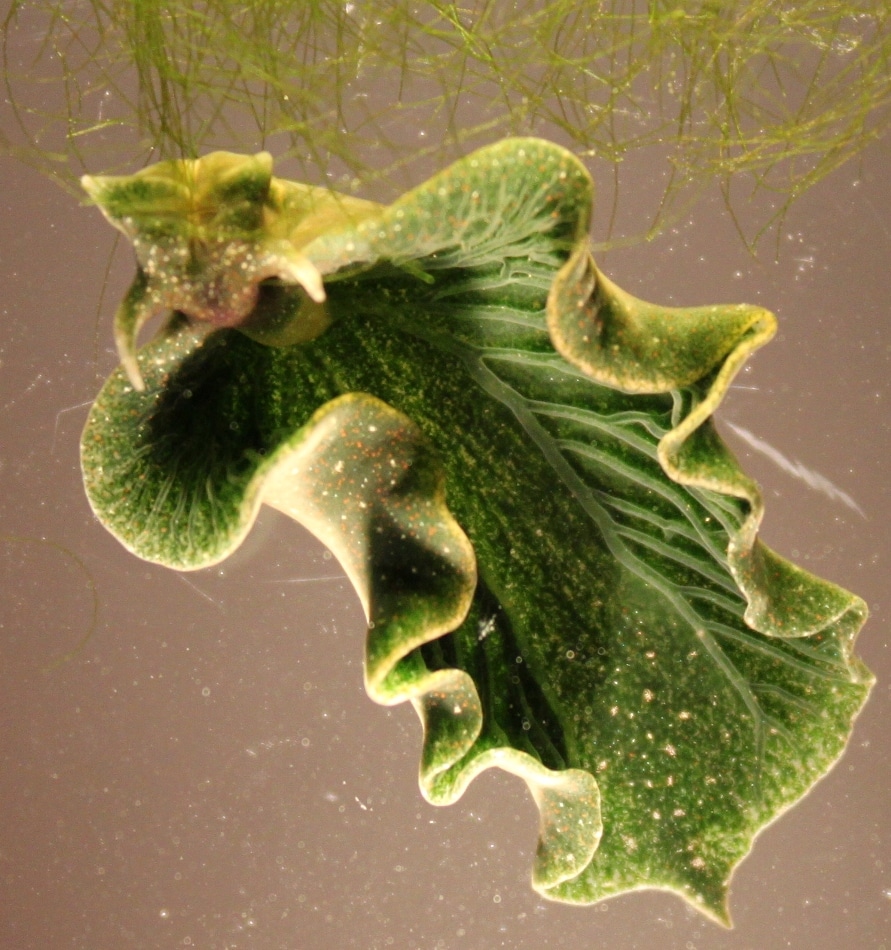May 3 2018
A research performed by Rutgers University–New Brunswick and other researchers has demonstrated that raw materials from algae are absorbed by a Northeast sea slug to provide its lifetime supply of solar-powered energy—a remarkable breakthrough similar to the addition of solar panels to one’s body.
 The sea slug, Elysia chlorotica, steals millions of green-colored plastids, which are like tiny solar panels, from algae. (Image credit: Karen N. Pelletreau/University of Maine)
The sea slug, Elysia chlorotica, steals millions of green-colored plastids, which are like tiny solar panels, from algae. (Image credit: Karen N. Pelletreau/University of Maine)
It’s a remarkable feat because it’s highly unusual for an animal to behave like a plant and survive solely on photosynthesis. The broader implication is in the field of artificial photosynthesis. That is, if we can figure out how the slug maintains stolen, isolated plastids to fix carbon without the plant nucleus, then maybe we can also harness isolated plastids for eternity as green machines to create bioproducts or energy. The existing paradigm is that to make green energy, we need the plant or alga to run the photosynthetic organelle, but the slug shows us that this does not have to be the case.
Debashish Bhattacharya, Senior Author & Professor in the Department of Biochemistry & Microbiology at Rutgers - New Brunswick
Elysia chlorotica, the sea slug, is a mollusk with the ability to grow over 2 inches long and has been spotted in the intertidal zone between Nova Scotia, Canada, and Martha’s Vineyard, Massachusetts, and also in Florida. The study published online in the Molecular Biology and Evolution journal reports that Vaucheria litorea, the nontoxic brown alga, is eaten by the juvenile sea slugs, which then become photosynthetic (i.e., solar-powered) by absorbing millions of algal plastids, similar to tiny solar panels, and store them in their gut lining.
Photosynthesis is the process by which plants and algae use sunlight to produce chemical energy (sugars) from water and carbon dioxide. The plastids of the brown alga are photosynthetic organelles (similar to the organs in people and animals) that have chlorophyll—a green pigment that absorbs light.
According to Bhattacharya, this specific alga is a perfect food source since there are no walls between adjoining cells in its body and it is typically a long tube loaded with plastids and nuclei. “When the sea slug makes a hole in the outer cell wall, it can suck out the cell contents and gather all of the algal plastids at once,” he stated.
The researchers took cues from investigations of other sea slugs and have contended that they steal and store plastids as food that can be digested at the time of adverse conditions, similar to the way camels store fat in their humps, stated Bhattacharya. This study has demonstrated that this not so for solar-powered E. chlorotica.
“It has this remarkable ability to steal these algal plastids, stop feeding and survive off the photosynthesis from the algae for the next six to eight months,” he stated.
The Rutgers team and other researchers adopted RNA sequencing (gene expression) to investigate their solar energy supply theory. The data indicate that the slug actively responds to the stolen plastids by preventing them from being digested and stimulating animal genes to absorb the algal photosynthetic products. Their discovery reflects those seen in corals that maintain dinoflagellates (also algae), as intact cells instead of stolen plastids, in symbiotic relationships.
Although E. chlorotica stores plastids, the algal nuclei that are also absorbed in together do not endure, and researchers have no clues how the sea slug manages to maintain the plastids and photosynthesis for several months in the absence of the nuclei that are usually required to regulate their function, stated Bhattacharya.
Pavel Vaysberg, a former undergrad in biotechnology in the School of Environmental and Biological Sciences; Dana C. Price, associate research professor in the Department of Plant Biology; and researchers from the University of Queensland in Australia, the University of Maine, and the University of Connecticut were the co-authors of the study.
Elysia chlorotica - photosynthetic sea slug movie 2
YouTube video of the sea slug Elysia chlorotica by Mary S. Tyler and Mary E. Rumpho.